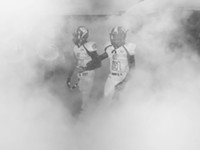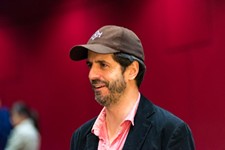Photos as Objects of Art and History
Magnum Photos collection gets read in new book
By Rod Machen, 12:54PM, Tue. Nov. 26, 2013
The Magnum Photos collection that now resides at the Harry Ransom Center is a beast. The new book Reading Magnum is an attempt to tame it. At 200,000 individual pieces, that’s no easy task, as editor Steven Hoelscher noted during a reading last Thursday sponsored by the Austin Center for Photography.
Hoelscher, a professor of American Studies and Geography at UT Austin, attacked this enormous project with a specific thesis: These photographs are not just images but physical objects, both of art and of history. Before a packed audience at the Contemporary Austin, he laid out his vision.
Because the collection comes from the famed Magnum Photos collective, this outlook is far from hyperbole. Since 1947, this illustrious group has created memorable photographs of every major event from modern times. While many of these images are now considered iconic, they didn’t start off as art objects but rather as documents that would be printed in publications around the world.
In his presentation, Hoelscher showed not just the fronts of prints but also examples of the backs, where a series of stamps, codes, and stains provided evidence of their busy lives, being ferried between the home office and various magazines and newspapers. The audience was fascinated by this and even offered comments about how poorly these prints would have been treated in their day, bereft of historical and artistic importance.
Three themes appear throughout the collection: war and conflict, portraiture, and the importance of geography and culture. From World War II to the Iraq War and at every point and time in between, Magnum photographers have been on the ground, firing away with their Leicas and Nikons. Hoelscher brought in esteemed scholars from a variety of academic institutions to write the introductory essays for each chapter, and this writing is the backbone of the work. Context is eminently important to this work. The most sobering moment of the night came with the viewing of a famous photo by Philip Jones Griffiths. Little Tiger depicts a young Vietnamese boy from the late Sixties, dressed head to toe in camo fatigues. The boy earned his name for having killed two people believed to be enemies of the state: his mother and his teacher. A silent room reflected the multiple levels of horror this one image conveys.
The fact that the collection ended up in Austin took enormous efforts by multiple parties. Magnum decided that its collection of prints was no longer useful in-house and had amassed considerable worth. Michael Dell’s investment firm purchased the collection and made arrangements to house it at the Ransom Center for archival and research purposes. The collection was delivered in 2009, and earlier this year, it was formally donated to the Ransom Center.
An audience member asked Hoelscher about the possibility of the collection eventually being digitized. While some cursory scanning has already happened, an archival-level digitization process would be an enormous undertaking, one Hoelscher isn’t sure will happen any time soon given the other priorities of the Ransom Center. As an academic and researcher, Hoelscher wishes the archive contained more internal documents about how Magnum was run. All photographers retain the rights to their own photos, but the collective allows them access and cachet they might not have individually. Herding this group of cats can’t be easy, but the work they produce is sublime. Reading Magnum: A Visual Archive of the Modern World puts it on full display.
A note to readers: Bold and uncensored, The Austin Chronicle has been Austin’s independent news source for over 40 years, expressing the community’s political and environmental concerns and supporting its active cultural scene. Now more than ever, we need your support to continue supplying Austin with independent, free press. If real news is important to you, please consider making a donation of $5, $10 or whatever you can afford, to help keep our journalism on stands.
Rod Machen, Dec. 12, 2013
Rod Machen, Oct. 24, 2013
March 10, 2024
Magnum Photos, Reading Magnum, Ransom Center, Steven Hoelscher










